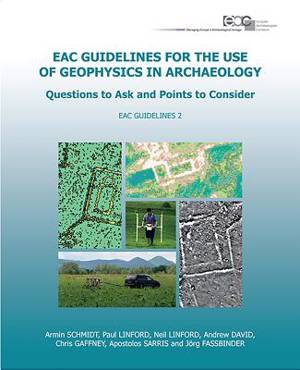
- Afhalen na 1 uur in een winkel met voorraad
- Gratis thuislevering in België vanaf € 30
- Ruim aanbod met 7 miljoen producten
- Afhalen na 1 uur in een winkel met voorraad
- Gratis thuislevering in België vanaf € 30
- Ruim aanbod met 7 miljoen producten
Zoeken
Eac Guidelines for the Use of Geophysics in Archaeology
Questions to Ask and Points to Consider
Armin Schmidt, Paul Linford, Neil Linford, Andrew David, Chris Gaffney
€ 37,45
+ 74 punten
Omschrijving
The aim of the guidelines of the European Archaeological Council (EAC) is to provide an overview of the issues
to be considered when undertaking or commissioning geophysical survey in archaeology. As every project differs in its requirements and variations in geological and environmental conditions leading to different geophysical responses, there is no single 'best' survey technique or methodology. This guide, in its European approach, highlights the various questions to be asked before a survey is undertaken. It does not provide recipe-book advice on how to do a geophysical survey or a tick list of which technique is suitable under what conditions as there is no formalized standard for the conduct of geophysical survey in archaeology.
A variety of geophysical techniques is available and an archaeological geophysicist will choose a particular methodology for collecting data with any of these techniques. The choices will depend on the archaeological questions being asked (whether broad, like "are there any archaeological features in this planned road corridor?" or detailed as in "is this wall foundation one brick wide or two?").
The following booklet discusses the issues for consideration when selecting geophysical techniques and methodologies, but do not specify specific requirements as these will vary according to context.
to be considered when undertaking or commissioning geophysical survey in archaeology. As every project differs in its requirements and variations in geological and environmental conditions leading to different geophysical responses, there is no single 'best' survey technique or methodology. This guide, in its European approach, highlights the various questions to be asked before a survey is undertaken. It does not provide recipe-book advice on how to do a geophysical survey or a tick list of which technique is suitable under what conditions as there is no formalized standard for the conduct of geophysical survey in archaeology.
A variety of geophysical techniques is available and an archaeological geophysicist will choose a particular methodology for collecting data with any of these techniques. The choices will depend on the archaeological questions being asked (whether broad, like "are there any archaeological features in this planned road corridor?" or detailed as in "is this wall foundation one brick wide or two?").
The following booklet discusses the issues for consideration when selecting geophysical techniques and methodologies, but do not specify specific requirements as these will vary according to context.
Specificaties
Betrokkenen
- Auteur(s):
- Uitgeverij:
Inhoud
- Aantal bladzijden:
- 138
- Taal:
- Engels
- Reeks:
- Reeksnummer:
- nr. 2
Eigenschappen
- Productcode (EAN):
- 9789639911734
- Verschijningsdatum:
- 31/03/2016
- Uitvoering:
- Met spiraalrug

Alleen bij Standaard Boekhandel
+ 74 punten op je klantenkaart van Standaard Boekhandel
Beoordelingen
We publiceren alleen reviews die voldoen aan de voorwaarden voor reviews. Bekijk onze voorwaarden voor reviews.








